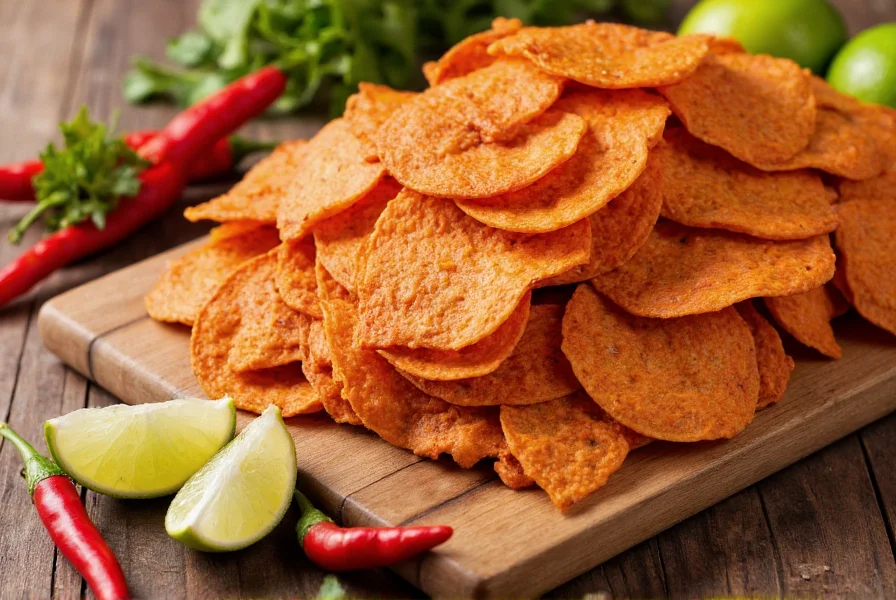These vibrant snacks have gained popularity across snack aisles worldwide, but many consumers remain unclear about what exactly distinguishes chili chips from other spicy snacks. Understanding the composition and characteristics of chili chips helps consumers make informed choices about this flavorful snack option.
What Defines Authentic Chili Chips
True chili chips differ from standard potato chips primarily through their seasoning blend and sometimes their base ingredient. While traditional potato chips use salt or simple seasonings, chili chips incorporate a complex spice mixture where chili powder serves as the dominant flavor. The base for chili chips can vary:
| Base Ingredient | Texture | Flavor Profile |
|---|---|---|
| Corn | Lighter, more brittle | Slightly sweet with pronounced spice |
| Potato | Thicker, heartier crunch | Earthy base with spicy finish |
| Cassava | Unique chewy-crisp texture | Neutral canvas for bold spices |
The seasoning blend typically includes ground chili peppers (like cayenne or ancho), garlic powder, onion powder, cumin, and salt. Some premium varieties incorporate real lime juice powder for that authentic chili-lime combination that has become increasingly popular in snack foods.
Origin and Evolution of Chili Chips
Chili chips trace their roots to Mexican culinary traditions where chili peppers have been used for thousands of years. The modern snack version emerged in the mid-20th century as food manufacturers began experimenting with seasoning potato and corn chips beyond basic salt flavors. The 1970s saw a significant expansion of flavored chips, with chili varieties gaining particular traction in regions with strong Mexican-American culinary influence.
Today, chili chips have evolved beyond their initial simple formulations. Artisanal producers now create small-batch chili chips using heirloom chili varieties, while major snack companies offer everything from mild chili-lime versions to extremely hot habanero-infused options catering to heat-seeking snackers.
Homemade Chili Chips Recipe Basics
Creating homemade chili chips allows for complete control over ingredients and spice levels. The basic process involves:
- Slicing potatoes or alternative bases thinly (1/8 inch)
- Soaking in cold water to remove excess starch
- Patting completely dry
- Tossing with oil and chili seasoning blend
- Baking at 400°F (200°C) for 15-20 minutes until crisp
For those seeking a healthier alternative to traditional fried versions, baked chili chips significantly reduce fat content while maintaining satisfying crunch. The key to perfect homemade chili chips lies in the seasoning ratio—too little chili powder results in bland chips, while too much can overwhelm the delicate potato or corn flavor.
Nutritional Profile Analysis
When evaluating the nutritional value of chili chips, several factors come into play. A standard 1-ounce (28g) serving of commercially produced chili chips typically contains:
- 150-160 calories
- 7-10g fat (depending on preparation method)
- 15-18g carbohydrates
- 1-2g protein
- 120-180mg sodium
- Trace amounts of vitamin C and iron from chili components
Compared to regular potato chips, chili chips often contain similar calorie counts but may offer marginal nutritional advantages through the capsaicin in chili peppers, which some studies suggest may temporarily boost metabolism. However, these effects are minimal in the small quantities typically consumed as snacks.
Chili Chips vs Similar Snack Options
Understanding how chili chips differ from comparable snack products helps consumers make appropriate choices:
- Chili chips vs regular potato chips: The primary difference lies in the seasoning—chili chips feature a complex spice blend while regular chips typically use only salt.
- Chili chips vs tortilla chips: Tortilla chips are made from corn masa and have a distinct triangular shape and corn flavor, while chili chips can be potato-based with chili seasoning added.
- Chili chips vs chili-flavored popcorn: Popcorn versions offer a lighter, airier texture with similar seasoning but significantly fewer calories per volume.
For those exploring chili chips nutritional benefits, it's important to note that while the chili components contain beneficial compounds, the overall snack remains primarily a source of carbohydrates and fats. Moderation remains key in any snack consumption.
Popular Regional Variations
Chili chips have evolved into numerous regional variations that reflect local taste preferences:
- Mexican-style: Often features lime juice powder alongside chili for that classic chili-lime combination, sometimes with tajín seasoning
- Asian-inspired: Incorporates gochugaru (Korean chili flakes) or Szechuan peppercorns for different heat profiles
- American Southwestern: Heavier on cumin and smoked paprika with moderate heat levels
- Extreme heat versions: Using ghost peppers or Carolina reapers for heat-seeking snackers
When searching for the best homemade chili chips recipe, consider your preferred heat level and base ingredient. Sweet potato chili chips have gained popularity for their natural sweetness that balances the spice, while cassava-based versions offer a gluten-free alternative with excellent crunch.
Serving Suggestions and Pairings
Chili chips shine when paired thoughtfully with complementary flavors. Consider these serving ideas:
- With cooling dips like avocado crema or Greek yogurt-based ranch
- As a crunchy topping for soups and salads
- Alongside fresh fruit like mango or pineapple to balance the heat
- With traditional Mexican dishes as an alternative to tortilla chips
For those exploring how to make chili chips from scratch, experimenting with different chili varieties can create unique flavor profiles. Ancho chili powder offers mild, fruity heat, while cayenne provides sharper, more immediate spice. Combining multiple chili types creates complex flavor layers that elevate the simple snack into something special.

Storage and Freshness Tips
To maintain optimal crunch and flavor, store chili chips in airtight containers away from moisture and heat sources. Commercially packaged chips typically remain fresh for 2-3 weeks after opening, while homemade versions are best consumed within 3-5 days. For extended storage, consider freezing in portion-sized bags—thaw at room temperature for 15 minutes before serving to restore maximum crispness.
Understanding the chili chips vs regular chips differences helps consumers select snacks that match their flavor preferences and dietary needs. While both satisfy crunchy snack cravings, chili chips offer that distinctive spicy kick that transforms a simple snack into a flavor experience.











 浙公网安备
33010002000092号
浙公网安备
33010002000092号 浙B2-20120091-4
浙B2-20120091-4